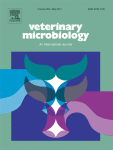View Item
- xmlui.general.dspace_homeCentros Regionales y EEAsCentro Regional Santa FeEEA RafaelaArtículos científicosxmlui.ArtifactBrowser.ItemViewer.trail
- DSpace Home
- Centros Regionales y EEAs
- Centro Regional Santa Fe
- EEA Rafaela
- Artículos científicos
- View Item
Detection of Staphylococcus aureus adhesion and biofilm-producing genes and their expression during internalization in bovine mammary epithelial cells
Abstract
Staphylococcus aureus is one of the most prevalent pathogens isolated from bovine mastitis, causing chronic intramammary infections (IMI) that limit profitable dairying. The course of infection is often associated with factors both related to the host and the bacterium. Aims of this study were to select S. aureus isolates from bovine IMI with different genotypic profiles harboring genes involved in adherence and biofilm production, to determine the
[ver mas...]
Staphylococcus aureus is one of the most prevalent pathogens isolated from bovine mastitis, causing chronic intramammary infections (IMI) that limit profitable dairying. The course of infection is often associated with factors both related to the host and the bacterium. Aims of this study were to select S. aureus isolates from bovine IMI with different genotypic profiles harboring genes involved in adherence and biofilm production, to determine the behavior of these strains in contact with bovine mammary epithelial cells (MAC-T) and the expression of those genes during bacterial-cell early interactions. The genetic diversity of 20 S. aureus strains that were isolated from milk samples taken from cows with persistent-P and non-persistent-NP IMI was high, discriminated into 13 fingerprint groups. The occurrence of genes coding for S. aureus surface proteins (clfA, clfB, fnbA, fnbB, fib, cna) and biofilm formation (icaA, icaD, icaC, bap) and in vitro biofilm-forming ability was not related to strain clinical origin (NP or P). Internalization of S. aureus into MAC-T cells was strain-dependent and internalized bacteria overexpressed adherence and biofilm-forming genes compared with those that remained in the supernatant of co-cultures; particularly those genes encoding FnBPs and IcaD. Strains yielding highest invasion percentages were those able to overexpress fnBP, irrespectively of the presence of other evaluated genes. Strains from NP IMI showed a greater multiplication capacity in vitro compared with strains from P IMI. These results provide new insights about S. aureus differential gene expression of adhesion-internalization factors during early interaction with mammary epithelial cells.
[Cerrar]

Author
Pereyra, Elizabet Amanda Lorena;
Renna, María Sol;
Picech, Florencia;
Baravalle, Celina;
Andreotti, Carolina Soledad;
Russi, Romina;
Calvinho, Luis Fernando;
Diez, Cristina;
Dallard, Bibiana Elisabet;
Fuente
Veterinary microbiology 183 : 69-77. (2016)
Date
2016
ISSN
0378-1135
Formato
pdf
Tipo de documento
artículo
Palabras Claves
Derechos de acceso
Restringido
 Excepto donde se diga explicitamente, este item se publica bajo la siguiente descripción: Creative Commons Attribution-NonCommercial-ShareAlike 2.5 Unported (CC BY-NC-SA 2.5)
Excepto donde se diga explicitamente, este item se publica bajo la siguiente descripción: Creative Commons Attribution-NonCommercial-ShareAlike 2.5 Unported (CC BY-NC-SA 2.5)

